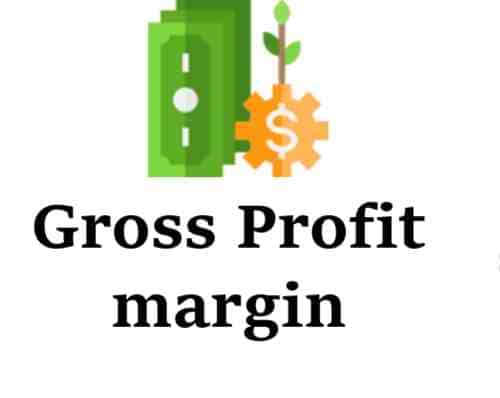A business is expected to understand how its sales are performing, which is why gross profit margin is a crucial indicator for a company’s sales performance since it reveals how much money your firm generated after paying for its direct operating expenses, which might include labour, materials, and other direct production costs.
You will learn more about how to calculate your business or organization’s gross profit margin in this article, as well as the significance of doing so.
What Is Gross Profit Margin?
Gross profit margin is a financial metric that shows how effectively a company manages its operations. It is a ratio that shows how well a company’s sales are performing based on how effectively its production process is working.
The efficiency with which a corporation can create and sell one or more items before deducting additional costs makes gross profit margin a significant financial measurement for both company managers and investors. The cost of goods sold for the business determines the gross profit margin. Depending on the details you require, it can be compared to the operating profit margin and net profit margin.
Gross profit margin may be saidto be the most crucial of the three profitability indicators since without a sufficient gross profit margin, your company won’t last long.
Why Is Gross Profit Margin Important?
The gross profit margin is an important key metric because it represents profit as a proportion of sales revenue. It is also used for assessing how well businesses generate income from their goods and services. As a result, it may be used to compare businesses with various sales figures more simply.
Gross profit margin concentrates on sales revenue as well, cutting out other costs and income that have an effect on a company’s overall profitability, including litigation settlements or interest income. It is occasionally used as a measure of a company’s management effectiveness.
How Do You Use the Gross Profit Margin?
A basic understanding of the gross profit margin can help to know the progress of your business. A high gross profit margins are an indication that management is successful at making money from the labour and other expenses incurred in producing its goods and services.
Gross profit margins that significantly fluctuate from quarter to quarter or year to year may sometimes be an indication of bad management. Aside from temporary production challenges that lower product quality and increase product returns, which lower net sales revenue, there are other issues that could affect it.
A market with intense competition and commoditized products, where there is little distinction between competing goods or services, might be indicated by steadily declining profit margins. Contrarily, a company may have fewer competitors or be better able to differentiate its products and command a higher price if its profit margins are consistently growing.
Yet, it can also be a sign that a business is overcharging for its goods and boosting margin at the price of volume; a 20% rise in profit is meaningless if sales fall by 50%.
When the gross profit margin gradually decreases over time, the business may need to make changes to support expansion. For instance, it could need to seek strategies to increase product sales volume to make up for diminishing profitability. Or, this can be a hint that the company has to change its business strategy, enhance its production methods to produce goods more effectively, or find other ways to reduce expenses.
Gross Profit Margin Example
A textile production company released a statement detailing its fiscal year 2022 total sales revenue of $200 billion and COGS of $100 billion. The following steps are taken by the business to determine the gross profit margin:
(Total net sales minus COGS) / Total net sales.
(($200 billion – $100 billion) / ($200 billion)) x 100 = 50% is the gross profit margin percentage.
The gross profit margin for the business is 50%. The corporation still has half of its revenue after paying the actual expenses related to making its machines. Before paying any business expenses, the corporation makes a 50-cent gross profit for every $1 in sales.
Gross Profit Margin Formula
The gross profit margin formula calculates the amount the business makes (profits) for each dollar in sales. In essence, the profit margin helps to comprehend the percentage of sales that remain after all costs have been paid by the business.
To calcualte the gross profit margin of your business
Subtract the cost of goods sold (COGS) from the net sales (gross revenues minus returns, allowances, and discounts).
Then divide the value you get by net sales
The formula term explained:
Net sales is the entire sum of money made from sales during the time period. It include discounts and deductions from returned goods. Net sales also appears at the top of the income statement and it is calculated by deducting costs from revenues..
Cost of goods sold, or COGS: Direct labour costs and any material costs incurred during the production or manufacturing of a company’s product are both included in the direct costs connected with producing goods.
What Is the Gross Profit margin Formula Ussed For?
The gross profit margin formula aids in determining a company’s earnings in relation to sales per dollar generated. There are three types of ratios that firms might receive when calculating profit margins: gross profit margin, operating profit margin, and net profit margin. Following the creation of these ratios, internal and external stakeholders of organizations can use them to make well-informed strategic decisions, including investment decisions.
Calculate Gross Profit Margin
Remember that your gross profit depends on your gross margin, thus you cannot determine the latter without knowing the former. Gross margin needs you to first know your gross profit, which you then divide by your entire sales income, as opposed to gross profit, which can be calculated using simply your total sales and COGS.
Follow these instructions to get the percentage of gross profit margin for your business:
Obtain the entire revenue. Overall revenue includes all earnings from sales, royalties, interest payments, rental property income, and other business-related operations.
Determine your COGS. The overall direct cost of creating your goods or services, including labour and raw materials, acts as the cost of goods sold. Certain indirect costs, like taxes and marketing, are excluded from the cost of goods sold.
Subtract the COGS from the total of your sales. This is the business’s gross profit.
Divide the gross profit by the overall income. The gross profit margin will be this.
Multiply your outcome by 100. You’ll get a % as a result.
Example on How to Calculate Gross Profit Margin
The following formula can be used with your income statement to determine gross profit in dollars:
Let’s calculate the gross profit margin using an example.
A year or so has passed since “Get Spa” first opened for business. Sandra wants to understand more clearly how costs impact the bottom line of her business. She then starts performing some calculations after opening her accounting program.
For the entire year, she makes $400,000 in sales.
$325,000 is her cost of goods sold. The labour, raw material, and manufacturing overhead costs incurred in the creation of the goods she sold are included in the cost of goods sold.
She would perform the following computation to convert gross profit to dollars:
$400,000 – $325,000 = $75,000
This indicates that Tina made a gross profit of $75,000.
how to determine the gross margin
Using Tina’s T-Shirts as an example,you can calculate it as follows: ($75,000 – $400,000) x 100 = 18.75%
The gross profit margin for “Get Spa” is 18.75%.
Gross Margin vs Gross Profit
In the corporate world, total revenue is not everything. A company with $1 million in annual sales but only $100,000 in expenses generates less money overall than a company with $1 million in annual sales but only $10,000 in expenses. In general, gross margin or gross profit are the two methods used to determine profitability because they are slightly different.
What is Gross Profit?
Gross profit, which is also known as net income, calculates a company’s profits in dollars after deducting its production costs. In other terms, a company’s gross profit is equal to its entire sales income minus costs of products sold (COGS).
For instance, if a kid runs a lemonade stand, the kids make $50 in total sales. But, they spent $25 for ice, lemonade mix, sugar, lemons, and paper cups before they opened for business. Their daily gross profit is $25 after deducting this $25 COGS from their $50 in total sales.
What Is Gross Margin?
Gross margin assesses the financial effectiveness of an organization. It calculates the amount of profit you make for every dollar of sales. More specifically, to get a percentage figure for your gross margin, multiply your gross profit by the sum of all your sales revenues and divide by 100.
In the lemonade stand example, you can calculate the kids’ gross margin as $25 divided by $50 (their total sales), multiply by 100, so their gross profit (their total sales minus their COGS) is $25. Hence, the lemonade stand has a gross margin of 50%. In other words, half of the money made at the lemonade stand was used to pay for supplies like sugar, cups, and lemons, with the remaining half going to the kids’ piggy banks.
Gross Profit VS Gross Margin: USES
Although both metrics determine the financial stability of a business, they do so in distinct ways. The distinction is that the gross margin is a percentage, and the gross profit is a flat amount. Both measures are useful for various purposes.
Gross Profit
You can use the gross profit to
- Calculate your purchasing power. Calculating gross profit allows you to know in precise dollar amounts how much you will make after expenses over a specific time period. This can help you determine how much money to put back into your company. A monetary amount is more useful than a percentage when making purchases. To look at variable costs. For instance, understanding gross profit lets you calculate how long it will take your company to pay off its pricey new juice machine.
- To examine variable expenses. Gross profit also demonstrates how effectively you employ resources like labor, raw materials, and supplies—whose prices change in accordance with your level of output.
Gross Margin:
- You can use the gross margin to make long-term plans. If your gross margin is consistent over an extended period of time, you know that you can forecast with reasonable certainty a certain gross profit on each dollar of sales. When you have a better understanding of your company’s financial situation, knowing your gross margin can help you run your operations more efficiently.
- You can also use the gross margin to grow your company. Having a baseline for predicted earnings per dollar of sales gives you useful information that you may use to justify an expansion or request more funding, even while line items like variable costs and direct expenses change over time.
What Does a 40% Gross Profit Margin Mean?
Gross margin is the portion of each dollar that your company keeps. As an illustration, if your gross margin is 40%, you will make $0.40 for every dollar of revenue.
What Does a 20% Profit Margin Mean?
The profit margin is a financial statistic used to estimate the portion of revenues that a company keeps after subtracting the expenses from earnings. For instance, a business would keep $0.20 from every dollar in sales if its profit margin was 20%.
What Is a Good Profit Margin Ratio?
A good gross profit margin is within the range of 10% to 20% and above. In general, a 10% net profit margin is regarded as typical, a 20% margin as high (or “excellent”), and a 5% margin as low. However, a good gross profit margin will differ significantly per industry.
What Factors Affect Gross Profit Margin?
The factors that affect gross profit margin are Revenue and cost of goods sold. COGS are the expenses a business incurs directly in producing a good. For instance, labor costs are a component of COGS. COGS also contains variable costs, which fluctuate according to the level of production.
In Conclusion
The gross profit margin is the profit made before deducting selling, general, and administrative expenses, which is the firm’s net profit margin. Gross profit margin is significant since it shows whether the revenues of your business are sufficient to pay for its expenses.
FAQs
What Is a “Good” Gross Profit Margin? Should It Be High or Low?
A healthy gross profit margin can be determined by the industry your business is in or by contrasting it with other businesses in the same sector. High gross margins signify efficient revenue creation based on business expenses.
How do I increase my gross profit margin?
- Reducing the price of items
- Make your offer more concise.
- Renegotiate with vendors to get better terms.
- Upsell to current customers.
- Boost productivity and efficiency.
Why is the gross profit margin ratio important?
Although the gross profit margin ratio can assist business owners and expert advisors in determining a company’s financial health, it works best when used to compare companies in the same industry or to follow a company’s performance over time.
The gross profit margin ratio can be used as a benchmark to surpass the industry average as well as a tool to determine whether your company is meeting the industry average.
Related Articles
- TRADING ON MARGIN: What It Means and Examples(
- GROSS REVENUE: Meaning, Evaluation, Formular, and Importance(
- WHAT IS CONTRIBUTION MARGIN?: Formula and Calculations
- GROSS PROFIT PERCENTAGE: Definition, Formula & How to calculate(
- Gross Profit Margin: Formula & How to Calculate the Gross Profit margin(






